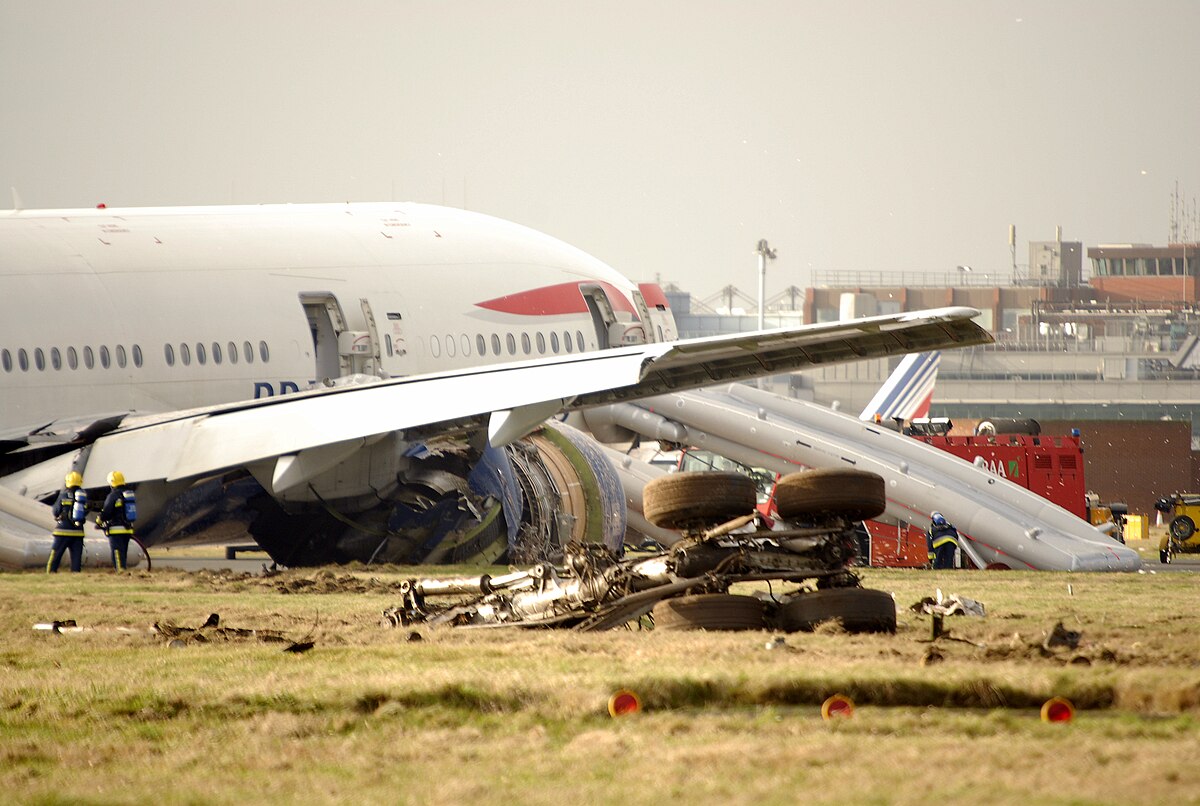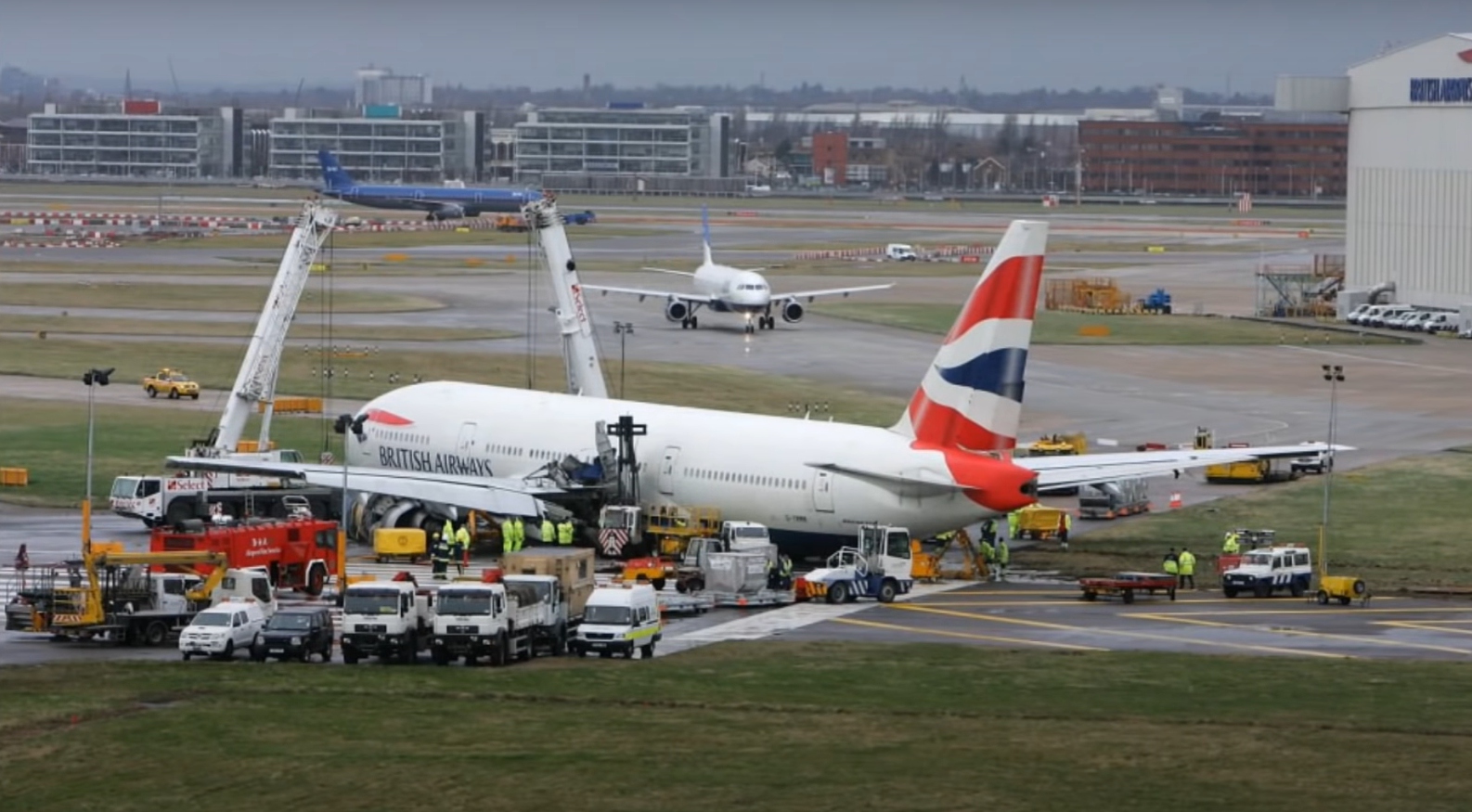
On a cold January morning in 2008, British Airways Flight 38 approached London’s Heathrow Airport under seemingly normal conditions after a grueling 12-hour flight from Beijing.
Passengers were preparing for landing, seat belts fastened and tray tables stowed, when something inexplicable happened. With the runway in sight and the plane mere seconds from touchdown, both engines of the Boeing 777 suddenly failed to deliver the thrust required to reach the airstrip.
The pilots were left gliding a nearly 300-ton aircraft towards one of the busiest airports in the world, and for the first time in the Boeing 777’s pristine 13-year history, the unthinkable happened—the aircraft crashed. What followed was a frantic investigation filled with confusion, speculation, and one of the strangest causes in aviation history. But perhaps most extraordinary was how every soul onboard survived what should have been a catastrophic disaster.
Flight 38 took off from Beijing at 10:09 a.m. local time with 136 passengers and 16 crew members onboard. The aircraft, powered by Rolls-Royce Trent 800 engines, had performed flawlessly since entering British Airways’ fleet in 2001.
Its destination was London Heathrow, and on the flight deck sat three experienced pilots: Captain Peter Burkill, Senior First Officer John Coward, and First Officer Conor McGinnes. Together, they had logged tens of thousands of hours of flight time, much of it on the Boeing 777.
They expected a long but uneventful flight cruising over Siberia, the Arctic, and northern Europe. But what they didn’t expect was the rare combination of altitude, air temperature, and fuel flow that would silently build a deadly trap over the course of the journey.
As the plane climbed through the atmosphere, it entered air that was significantly colder than usual. At cruising altitudes above 34,000 feet, temperatures dropped to a bone-chilling minus 76 degrees Celsius.
While fuel inside the tanks rarely freezes due to the heat generated by friction on the fuselage, the crew closely monitored fuel temperatures, ensuring they stayed safely above the critical freezing threshold of minus 47 degrees Celsius. Still, the environment was unusual.

The air outside remained colder than normal for the entirety of the flight, and as the pilots performed step climbs—small altitude increases to improve efficiency—the plane’s engines consumed less fuel than expected during those climbs. This turned out to be a crucial factor.
By the time Flight 38 approached London, it had burned off much of its 79 tons of fuel and had settled into a typical approach pattern, following instructions from air traffic control.
The aircraft was on final approach to runway 27L, flaps down, gear extended, and autopilot and auto-throttle engaged. At 1,200 feet, the auto-throttle made a minor adjustment, commanding the engines to increase thrust.
But shockingly, the right engine did the opposite—it decreased. Seven seconds later, the left engine followed suit. At just 600 feet above the ground, the Boeing 777 was now effectively a glider.
The cockpit became a flurry of confused assessments. The thrust levers were pushed forward manually, but the engines remained at idle. There were no warnings, no immediate clues. It wasn’t a double-engine failure in the traditional sense.
The systems weren’t indicating anything that would suggest a shutdown, and yet there was no power. The aircraft’s speed began to decay rapidly. The autopilot tried to maintain glide slope by raising the nose, but this only increased drag and pushed the plane closer to a stall. Captain Burkill and First Officer Coward had mere seconds to react.
Understanding the aircraft wouldn’t make the runway, Burkill made a crucial decision. He reduced the flap setting from 30 degrees to 25 in an effort to reduce drag, gaining precious meters of glide distance. This move bought the plane enough momentum to clear the houses that lay between the plane and the airport perimeter.

The descent rate, still dangerously high, dropped from 1,800 feet per minute to 1,400. The stick shaker activated, warning of an imminent stall, and Coward pushed the nose down to prevent disaster. Ten seconds from impact, Burkill declared a Mayday.
The Boeing 777 crashed just 330 meters short of the runway, bouncing and skidding before coming to rest with broken landing gear and a punctured fuselage. Astonishingly, all 152 people onboard survived. Only one passenger suffered a serious injury—a broken leg.
In the aftermath, the world’s media scrambled for answers. British Airways had one of the best safety records in aviation. The Boeing 777 was known for its flawless performance. What invisible force could rob both engines of power at the same moment with no warning?
Some speculated a software bug. Others blamed radio interference from the nearby Prime Minister’s motorcade. But as investigators dug deeper, they found a mystery buried not in the plane’s electronics, but in its fuel system.
The key lay in how ice forms naturally in jet fuel during flight. Most flights burn fuel at rates and in conditions that naturally flush out any ice that forms. But Flight 38 was different. Because the pilots used a slow vertical speed for their climbs, fuel flow remained low even during altitude changes, allowing ice crystals to accumulate in the system.
These crystals clung to the interior of the fuel lines for hours, held in place by the cold environment. As the aircraft descended, the engines demanded more thrust, increasing the fuel flow rapidly. This sudden surge dislodged the accumulated ice, sending it crashing into a vulnerable component known as the fuel-oil heat exchanger.

The blockage that followed wasn’t complete, but it was enough to choke the engines at the most critical moment. The system simply couldn’t handle the sudden flood of ice, and the engines were starved of fuel precisely when maximum power was needed for landing. The phenomenon was so rare and so specific that it had never occurred before in over a decade of triple seven operations. British Airways Flight 38 became a one-in-a-million cautionary tale.
After months of investigation, engineers from Rolls-Royce redesigned the heat exchanger to prevent similar blockages. Boeing issued new guidance to flight crews on handling suspected fuel icing.
The aviation industry took a long, hard look at assumptions previously considered safe and realized how a string of seemingly minor factors—extreme cold, low fuel flow, and a high-thrust approach—could line up like dominoes to create disaster. Since those changes, no similar incident has occurred.
What saved the passengers that day was not luck alone, but the presence of experienced pilots who made split-second decisions that made the difference between life and death. In simulations, even Boeing’s test pilots couldn’t improve on the glide achieved by Burkill and Coward.
The flight stands as a testament to human skill in the age of automation and a chilling reminder that even the most advanced machines are vulnerable to nature’s smallest weapons—ice crystals invisible to the eye, waiting in the dark.
British Airways Flight 38 did not end in tragedy, but it came terrifyingly close. The scars left on the aircraft and the lessons learned from its near loss now live on in the procedures and engineering of modern aviation. And for those 152 souls onboard, it will forever remain a story of a silent killer, a vanishing cause, and a miracle crash that rewrote the rules of flight.
-1749897755-q80.webp)


-1750403064-q80.webp)